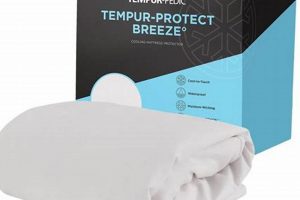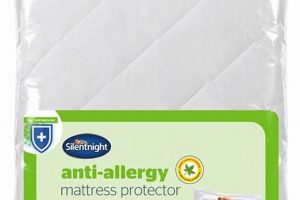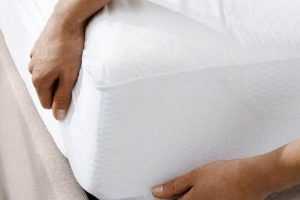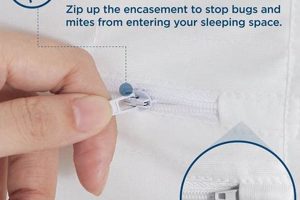These accessories, generally crafted from materials like cotton, polyester, or vinyl, serve as a barrier encasing a sleeping surface. This protective layer shields against a variety of potential contaminants and damages. For example, applying this type of covering can prevent liquids from penetrating the mattress, safeguarding against stains and potential mold growth.
The utilization of a barrier between the sleeper and the mattress extends the lifespan of the core sleeping surface. It offers a cost-effective approach to maintaining hygiene and preventing the accumulation of allergens, dust mites, and bed bugs. Historically, simpler versions were used to prevent feather leakage from down-filled mattresses, evolving to modern designs offering waterproof and hypoallergenic properties.
The subsequent sections will delve into the specific types available, proper care and maintenance procedures, and factors to consider when selecting the optimal product to suit individual needs and budgets.
Protecting Sleep Surfaces
Effective maintenance of a sleeping surface relies on understanding how to maximize the utility of its protective covering. The following guidelines offer practical steps for prolonging the life and cleanliness of this essential bedding component.
Tip 1: Prioritize Waterproofing. Incontinence, spills, and perspiration can damage a mattress. A waterproof layer integrated into the encasement offers significant protection. Look for polyurethane or thermoplastic polyurethane (TPU) backing.
Tip 2: Consider Allergy Resistance. Individuals with sensitivities should select a covering made from hypoallergenic materials. Tightly woven fabrics prevent dust mite and allergen penetration.
Tip 3: Regularly Launder the Cover. Manufacturers generally recommend washing these items every one to two months. Consult the care label for specific washing instructions to prevent shrinkage or damage.
Tip 4: Inspect for Damage. Periodically check the integrity of the protective layer. Tears, punctures, or seam separations compromise its protective function and necessitate repair or replacement.
Tip 5: Choose the Correct Size. An ill-fitting encasement will not provide adequate protection and may shift or bunch during sleep. Measure the mattress depth accurately before purchasing.
Tip 6: Understand Material Properties. Different materials offer varying degrees of breathability and comfort. Cotton blends tend to be more breathable, while vinyl offers maximum waterproof protection but may be less comfortable.
Tip 7: Evaluate Zipper Quality. For full encasements, the zipper is a critical component. Select a product with a durable, rust-resistant zipper that can withstand frequent use.
These tips highlight the importance of selecting, using, and maintaining a high-quality mattress covering. Implementing these practices will contribute to a cleaner, healthier, and more durable sleeping environment.
The subsequent section will address common misconceptions about mattress protection and offer evidence-based recommendations for informed consumer choices.
1. Waterproof barrier
A waterproof barrier is a critical component within the realm of mattress protection. Its primary function is to prevent liquids from penetrating the mattress core, thereby safeguarding it against stains, mold growth, and the degradation of internal materials. This barrier typically consists of a membrane, often polyurethane or thermoplastic polyurethane (TPU), laminated to a fabric surface. The presence of this layer significantly extends the mattress lifespan by preventing irreversible damage caused by spills, accidents, or perspiration.
The practical significance of a waterproof element becomes apparent in various scenarios. For example, within households with young children or pets, accidental spills are a common occurrence. Without adequate protection, these liquids can quickly permeate the mattress, leading to unsanitary conditions and potential health hazards. Similarly, in healthcare settings, waterproof features are essential for maintaining hygiene and preventing the spread of infections. Furthermore, the impermeability safeguards against the accumulation of moisture, which can foster the growth of mold and mildew, particularly in humid environments.
Therefore, the inclusion of a waterproof feature provides a tangible return on investment by preventing costly mattress replacements and promoting a healthier sleep environment. Choosing mattress safeguards that prioritize robust waterproofing demonstrates an understanding of the potential risks posed by liquid exposure and a commitment to maintaining the integrity of the sleeping surface.
2. Allergen defense
Allergen defense represents a critical function of mattress protection, addressing the pervasive presence of allergens within the sleep environment. The strategic implementation of protective measures can significantly reduce exposure to these triggers, promoting a healthier and more comfortable rest.
- Dust Mite Barrier
Dust mites, microscopic organisms thriving in bedding, are a primary source of allergens. Mattress encasements with tightly woven fabrics, typically featuring pore sizes less than 10 micrometers, create an effective barrier against mite migration and fecal matter accumulation within the mattress core. This physical barrier minimizes allergenic exposure, particularly benefiting individuals with asthma or dust mite allergies.
- Pet Dander Reduction
Households with pets often experience elevated levels of pet dander, a potent allergen. Mattress protection designed with a smooth, non-porous surface can minimize the adherence of dander to the mattress fibers. Regular cleaning of the covering further reduces the accumulation of pet allergens, creating a cleaner sleep environment.
- Mold Spore Prevention
Moisture accumulation within a mattress can foster mold growth, releasing allergenic spores into the air. Waterproof mattress encasements not only protect against liquid spills but also prevent internal moisture buildup, thereby inhibiting mold proliferation and reducing allergen levels. This is particularly relevant in humid climates or for individuals prone to night sweats.
- Hypoallergenic Material Selection
The selection of materials used in mattress covers plays a crucial role in allergen defense. Natural fibers, such as cotton, may harbor allergens if not properly treated. Synthetic materials, like polyester or microfiber, are often hypoallergenic and less prone to accumulating allergens. Certifications such as OEKO-TEX Standard 100 ensure that materials are free from harmful substances and potential allergens.
The integration of these allergen defense strategies within a mattress protection system serves to mitigate exposure to common allergens, thereby improving sleep quality and overall well-being. The effectiveness of these measures hinges on proper selection, regular maintenance, and consistent implementation within the sleep environment. Selecting protective covers with these features can substantially reduce the presence of allergens, promoting a healthier and more restful sleep.
3. Stain prevention
Stain prevention constitutes a primary function of mattress protection. The capacity to repel or resist staining significantly extends the lifespan and maintains the aesthetic integrity of the mattress, ensuring a cleaner and more hygienic sleep environment.
- Liquid Impermeability
The most effective stain prevention strategy lies in the incorporation of a liquid-impermeable layer. Materials such as polyurethane or TPU create a barrier preventing fluids from penetrating the mattress fibers. This is particularly relevant in mitigating stains caused by spills, bodily fluids, or accidental discharges. For instance, a waterproof covering will prevent a spilled beverage from soaking into the mattress, thereby averting a persistent stain and potential mold growth.
- Surface Treatment
Certain mattress protectors feature surface treatments that enhance their stain-resistant properties. These treatments, often involving hydrophobic or oleophobic coatings, reduce the surface tension of the fabric, causing liquids to bead up and roll off rather than penetrate. This mechanism is particularly effective against oil-based stains and facilitates easier cleaning of spills before they set in.
- Material Composition
The inherent properties of the materials used in mattress protection contribute to stain prevention. Tightly woven fabrics, such as microfiber or polyester blends, are less porous than loosely woven materials like cotton. This tighter weave restricts the absorption of liquids and particulate matter, reducing the likelihood of staining. Additionally, synthetic materials often exhibit greater resistance to staining compared to natural fibers.
- Regular Maintenance
While a mattress protector offers a degree of stain resistance, regular maintenance is essential for long-term stain prevention. Prompt cleaning of spills with appropriate cleaning agents prevents stains from setting into the fabric. Regular laundering of the protector, as per the manufacturer’s instructions, removes accumulated dirt, dust, and potential staining agents, maintaining its protective capabilities.
In summary, the effectiveness of stain prevention hinges on a combination of impermeable barriers, surface treatments, material composition, and consistent maintenance. A comprehensive approach encompassing these elements ensures that the mattress remains protected from staining, preserving its appearance and extending its useful life. Effective stain prevention not only protects the mattress, but reduces the need to hire cleaning services to remove stains, saving you money.
4. Bed bug protection
Bed bug protection is a critical function of encasing mattresses, preventing infestation and mitigating the associated health and economic consequences. Mattress encasements act as a physical barrier, denying bed bugs access to harborage within the mattress core. This preventative measure is particularly relevant in multi-unit dwellings, hotels, and other environments where bed bug transmission is elevated. Without proper encasement, mattresses become vulnerable to infestation, leading to costly remediation efforts and potential health concerns for occupants. A real-world example involves apartment complexes where untreated mattresses quickly become infested, leading to widespread bed bug problems throughout the building.
The effectiveness of bed bug protection relies on several key characteristics of the encasement. Zippered closures must be robust and tightly sealed to prevent entry. Fabric weave should be sufficiently dense to prevent bed bugs from penetrating the material. Furthermore, encasements should be designed for easy inspection and cleaning to identify and address any potential breaches or infestations promptly. Failure to adhere to these standards compromises the protective function and increases the risk of bed bug establishment. Proper installation of the encasement is also essential; if not installed correctly, it will leave space for bed bugs to enter and nest on the mattress.
In summary, mattress encasements specifically designed for bed bug protection offer a proactive approach to managing these pests. These covers create a critical barrier, thus preventing infestation and its associated health and economic burdens. Their efficacy hinges on selecting encasements with appropriate design features, maintaining vigilance in their inspection and cleaning, and understanding that this measure is most effective when integrated into a comprehensive pest management strategy.
5. Extended Lifespan
The correlation between protective bedding and an extended mattress lifespan is substantial. By shielding the core mattress from various detrimental factors, these accessories contribute significantly to its longevity and sustained performance. The following aspects illustrate how this protection translates into an increased usable life for the sleeping surface.
- Barrier Against Degradation
Encasements act as a primary defense against liquid spills, bodily fluids, and the accumulation of dust and debris. These contaminants, if allowed to penetrate the mattress, can degrade internal materials such as foam and fiber, leading to premature sagging, loss of support, and ultimately, the need for replacement. For instance, repeated exposure to perspiration can break down foam padding, diminishing its resilience and comfort over time.
- Prevention of Allergen Accumulation
Mattress protection minimizes the buildup of allergens such as dust mites, pet dander, and mold spores within the mattress. These allergens not only pose health risks but also contribute to the deterioration of mattress materials. Dust mites, for example, feed on dead skin cells that accumulate in bedding, and their presence can lead to the breakdown of fibers. By limiting allergen accumulation, these coverings maintain the integrity of the mattress structure.
- Mitigation of Wear and Tear
Protective layers reduce direct friction between the mattress and external forces, such as body weight and movement. This mitigation of wear and tear preserves the structural integrity of the mattress, preventing premature compression of coils or flattening of foam layers. This is especially evident in mattresses subjected to high levels of use, where consistent protection can significantly extend their lifespan.
- Maintenance of Warranty Coverage
Many mattress warranties include clauses that stipulate proper maintenance and protection. Stains, damage from spills, or evidence of infestation can void the warranty. Using a protective layer that effectively safeguards against these issues ensures that the warranty remains valid, providing an additional layer of security and potential cost savings should any manufacturing defects arise.
The factors outlined above demonstrate the tangible benefits of mattress protection in prolonging the lifespan of the investment. This protection results in deferred replacement costs and a sustained quality of sleep over an extended period.
6. Hygiene maintenance
Hygiene maintenance represents a cornerstone in preserving the cleanliness and sanitation of mattresses. Mattress protection, through the implementation of suitable coverings, plays a direct and significant role in maintaining optimal hygiene standards. This encompasses minimizing the accumulation of contaminants, facilitating easier cleaning, and promoting a healthier sleep environment.
- Contaminant Barrier
A primary function is to act as a physical barrier against the ingress of various contaminants, including body fluids, dust mites, allergens, and particulate matter. This barrier prevents these substances from penetrating the mattress core, where they can foster bacterial growth, generate odors, and trigger allergic reactions. For example, an impermeable membrane will prevent sweat and saliva from seeping into the mattress, thereby inhibiting the proliferation of bacteria and reducing the risk of unpleasant smells.
- Surface Cleanability
Protective coverings are designed to be easily cleaned and sanitized, facilitating the removal of surface contaminants. This is achieved through the use of materials that are resistant to staining and can be wiped down with appropriate cleaning agents. Regular cleaning of the covering helps prevent the buildup of dirt, debris, and allergens, maintaining a hygienic sleep surface. For example, a vinyl covering can be easily wiped clean with a disinfectant solution, effectively removing surface bacteria and viruses.
- Allergen Reduction
Certain protective coverings incorporate features designed to minimize allergen accumulation. These features may include tightly woven fabrics that prevent dust mite penetration or hypoallergenic materials that resist the growth of mold and mildew. By reducing the presence of allergens, mattress protection can improve air quality and alleviate symptoms for individuals with allergies or asthma. As an example, a cover made of tightly woven microfiber can significantly reduce dust mite populations within the mattress, lowering exposure to dust mite allergens.
- Odor Control
The prevention of contaminant penetration and regular cleaning contribute to effective odor control. Protective measures help minimize the development of unpleasant odors that can arise from bacterial growth, moisture accumulation, or the presence of bodily fluids. By preventing these issues, mattress covers maintain a fresher and more hygienic sleep environment. For instance, a waterproof cover will prevent urine from soaking into the mattress, thereby preventing the persistent odor associated with such incidents.
The discussed facets underscore the integral connection between hygiene maintenance and protective coverings. By implementing effective protection, the longevity and hygiene of sleeping surfaces are increased. This ensures a cleaner, healthier, and more comfortable sleep.
Frequently Asked Questions Regarding Mattress Protection
The following section addresses common inquiries concerning the purpose, selection, and maintenance of coverings designed to safeguard mattresses.
Question 1: What is the primary function of a mattress covering?
The main function of a mattress covering is to protect the mattress from fluids, allergens, dust mites, and bed bugs, thus extending its lifespan and maintaining hygiene.
Question 2: Are all coverings waterproof?
Not all coverings are waterproof. Some offer water resistance, while others provide complete impermeability. The level of protection varies depending on the materials used in construction.
Question 3: How often should a mattress covering be cleaned?
It is generally recommended to clean a mattress covering every one to two months, or more frequently if spills or accidents occur. Specific cleaning instructions should be followed as indicated by the manufacturer’s label.
Question 4: Can a mattress covering prevent bed bug infestations?
Certain mattress encasements designed with tightly sealed zippers and bed bug-proof fabrics can prevent bed bugs from infesting the mattress. However, it is crucial to select a product specifically labeled for bed bug protection.
Question 5: Will a mattress covering affect the comfort of the mattress?
Some coverings may slightly alter the feel of the mattress. However, selecting a covering made from breathable materials, such as cotton or bamboo, can minimize any potential impact on comfort.
Question 6: Does using a covering negate the need for regular mattress cleaning?
While a covering provides a barrier against contaminants, it does not eliminate the need for periodic mattress cleaning. Mattresses should still be vacuumed regularly to remove dust and allergens.
The answers provided above offer a foundational understanding of mattress coverings. Proper implementation and maintenance are essential for realizing the full benefits of these protective accessories.
The subsequent section will explore various types of mattress coverings available on the market, outlining their specific features and benefits.
Protect a Bed Mattress Protectors
The preceding discourse has elucidated the multifaceted importance of implements designed to safeguard sleeping surfaces. These items serve as a crucial line of defense against a variety of threats, from liquid damage and allergen accumulation to pest infestation, ultimately contributing to the extended lifespan and enhanced hygiene of the underlying mattress.
Prudent investment in appropriate mattress protection represents a commitment to both the longevity of bedding and the well-being of individuals. Recognizing the significance of these preventive measures allows for informed decisions that ensure a cleaner, healthier, and more sustainable sleep environment.



![Best Malouf Mattress Protector [Guide & Review] Organic & Natural Mattress Buyer’s Guide: Non-Toxic Sleep Solutions Best Malouf Mattress Protector [Guide & Review] | Organic & Natural Mattress Buyer’s Guide: Non-Toxic Sleep Solutions](https://mattressworldpa.com/wp-content/uploads/2025/07/th-2531-300x200.jpg)
![Best Purple Protector Mattress: [Benefit] & Protection! Organic & Natural Mattress Buyer’s Guide: Non-Toxic Sleep Solutions Best Purple Protector Mattress: [Benefit] & Protection! | Organic & Natural Mattress Buyer’s Guide: Non-Toxic Sleep Solutions](https://mattressworldpa.com/wp-content/uploads/2025/07/th-2530-300x200.jpg)


